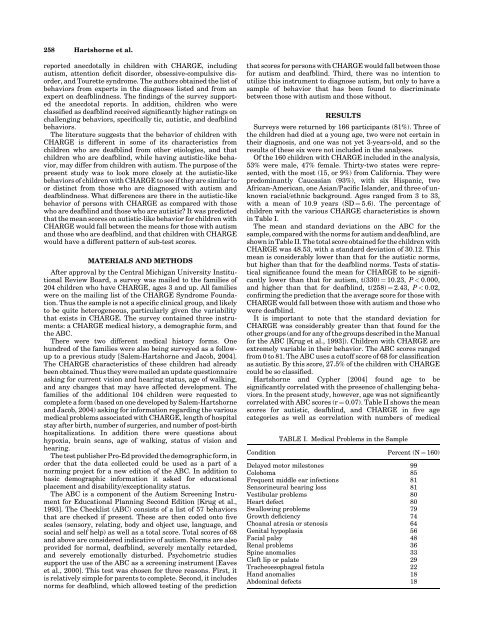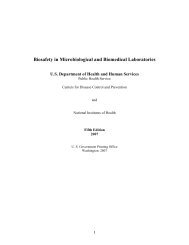Autistic-like behavior in CHARGE syndrome - Central Michigan ...
Autistic-like behavior in CHARGE syndrome - Central Michigan ...
Autistic-like behavior in CHARGE syndrome - Central Michigan ...
Create successful ePaper yourself
Turn your PDF publications into a flip-book with our unique Google optimized e-Paper software.
258 Hartshorne et al.<br />
reported anecdotally <strong>in</strong> children with <strong>CHARGE</strong>, <strong>in</strong>clud<strong>in</strong>g<br />
autism, attention deficit disorder, obsessive-compulsive disorder,<br />
and Tourette <strong>syndrome</strong>. The authors obta<strong>in</strong>ed the list of<br />
<strong>behavior</strong>s from experts <strong>in</strong> the diagnoses listed and from an<br />
expert on deafbl<strong>in</strong>dness. The f<strong>in</strong>d<strong>in</strong>gs of the survey supported<br />
the anecdotal reports. In addition, children who were<br />
classified as deafbl<strong>in</strong>d received significantly higher rat<strong>in</strong>gs on<br />
challeng<strong>in</strong>g <strong>behavior</strong>s, specifically tic, autistic, and deafbl<strong>in</strong>d<br />
<strong>behavior</strong>s.<br />
The literature suggests that the <strong>behavior</strong> of children with<br />
<strong>CHARGE</strong> is different <strong>in</strong> some of its characteristics from<br />
children who are deafbl<strong>in</strong>d from other etiologies, and that<br />
children who are deafbl<strong>in</strong>d, while hav<strong>in</strong>g autistic-<strong>like</strong> <strong>behavior</strong>,<br />
may differ from children with autism. The purpose of the<br />
present study was to look more closely at the autistic-<strong>like</strong><br />
<strong>behavior</strong>s of children with <strong>CHARGE</strong> to see if they are similar to<br />
or dist<strong>in</strong>ct from those who are diagnosed with autism and<br />
deafbl<strong>in</strong>dness. What differences are there <strong>in</strong> the autistic-<strong>like</strong><br />
<strong>behavior</strong> of persons with <strong>CHARGE</strong> as compared with those<br />
who are deafbl<strong>in</strong>d and those who are autistic? It was predicted<br />
that the mean scores on autistic-<strong>like</strong> <strong>behavior</strong> for children with<br />
<strong>CHARGE</strong> would fall between the means for those with autism<br />
and those who are deafbl<strong>in</strong>d, and that children with <strong>CHARGE</strong><br />
would have a different pattern of sub-test scores.<br />
MATERIALS AND METHODS<br />
After approval by the <strong>Central</strong> <strong>Michigan</strong> University Institutional<br />
Review Board, a survey was mailed to the families of<br />
204 children who have <strong>CHARGE</strong>, ages 3 and up. All families<br />
were on the mail<strong>in</strong>g list of the <strong>CHARGE</strong> Syndrome Foundation.<br />
Thus the sample is not a specific cl<strong>in</strong>ical group, and <strong>like</strong>ly<br />
to be quite heterogeneous, particularly given the variability<br />
that exists <strong>in</strong> <strong>CHARGE</strong>. The survey conta<strong>in</strong>ed three <strong>in</strong>struments:<br />
a <strong>CHARGE</strong> medical history, a demographic form, and<br />
the ABC.<br />
There were two different medical history forms. One<br />
hundred of the families were also be<strong>in</strong>g surveyed as a followup<br />
to a previous study [Salem-Hartshorne and Jacob, 2004].<br />
The <strong>CHARGE</strong> characteristics of these children had already<br />
been obta<strong>in</strong>ed. Thus they were mailed an update questionnaire<br />
ask<strong>in</strong>g for current vision and hear<strong>in</strong>g status, age of walk<strong>in</strong>g,<br />
and any changes that may have affected development. The<br />
families of the additional 104 children were requested to<br />
complete a form (based on one developed by Salem-Hartshorne<br />
and Jacob, 2004) ask<strong>in</strong>g for <strong>in</strong>formation regard<strong>in</strong>g the various<br />
medical problems associated with <strong>CHARGE</strong>, length of hospital<br />
stay after birth, number of surgeries, and number of post-birth<br />
hospitalizations. In addition there were questions about<br />
hypoxia, bra<strong>in</strong> scans, age of walk<strong>in</strong>g, status of vision and<br />
hear<strong>in</strong>g.<br />
The test publisher Pro-Ed provided the demographic form, <strong>in</strong><br />
order that the data collected could be used as a part of a<br />
norm<strong>in</strong>g project for a new edition of the ABC. In addition to<br />
basic demographic <strong>in</strong>formation it asked for educational<br />
placement and disability/exceptionality status.<br />
The ABC is a component of the Autism Screen<strong>in</strong>g Instrument<br />
for Educational Plann<strong>in</strong>g Second Edition [Krug et al.,<br />
1993]. The Checklist (ABC) consists of a list of 57 <strong>behavior</strong>s<br />
that are checked if present. These are then coded onto five<br />
scales (sensory, relat<strong>in</strong>g, body and object use, language, and<br />
social and self help) as well as a total score. Total scores of 68<br />
and above are considered <strong>in</strong>dicative of autism. Norms are also<br />
provided for normal, deafbl<strong>in</strong>d, severely mentally retarded,<br />
and severely emotionally disturbed. Psychometric studies<br />
support the use of the ABC as a screen<strong>in</strong>g <strong>in</strong>strument [Eaves<br />
et al., 2000]. This test was chosen for three reasons. First, it<br />
is relatively simple for parents to complete. Second, it <strong>in</strong>cludes<br />
norms for deafbl<strong>in</strong>d, which allowed test<strong>in</strong>g of the prediction<br />
that scores for persons with <strong>CHARGE</strong> would fall between those<br />
for autism and deafbl<strong>in</strong>d. Third, there was no <strong>in</strong>tention to<br />
utilize this <strong>in</strong>strument to diagnose autism, but only to have a<br />
sample of <strong>behavior</strong> that has been found to discrim<strong>in</strong>ate<br />
between those with autism and those without.<br />
RESULTS<br />
Surveys were returned by 166 participants (81%). Three of<br />
the children had died at a young age, two were not certa<strong>in</strong> <strong>in</strong><br />
their diagnosis, and one was not yet 3-years-old, and so the<br />
results of these six were not <strong>in</strong>cluded <strong>in</strong> the analyses.<br />
Of the 160 children with <strong>CHARGE</strong> <strong>in</strong>cluded <strong>in</strong> the analysis,<br />
53% were male, 47% female. Thirty-two states were represented,<br />
with the most (15, or 9%) from California. They were<br />
predom<strong>in</strong>antly Caucasian (93%), with six Hispanic, two<br />
African-American, one Asian/Pacific Islander, and three of unknown<br />
racial/ethnic background. Ages ranged from 3 to 33,<br />
with a mean of 10.9 years (SD ¼ 5.6). The percentage of<br />
children with the various <strong>CHARGE</strong> characteristics is shown<br />
<strong>in</strong> Table I.<br />
The mean and standard deviations on the ABC for the<br />
sample, compared with the norms for autism and deafbl<strong>in</strong>d, are<br />
shown <strong>in</strong> Table II. The total score obta<strong>in</strong>ed for the children with<br />
<strong>CHARGE</strong> was 48.53, with a standard deviation of 30.12. This<br />
mean is considerably lower than that for the autistic norms,<br />
but higher than that for the deafbl<strong>in</strong>d norms. Tests of statistical<br />
significance found the mean for <strong>CHARGE</strong> to be significantly<br />
lower than that for autism, t(330) ¼ 10.23, P < 0.000,<br />
and higher than that for deafbl<strong>in</strong>d, t(258) ¼ 2.43, P < 0.02,<br />
confirm<strong>in</strong>g the prediction that the average score for those with<br />
<strong>CHARGE</strong> would fall between those with autism and those who<br />
were deafbl<strong>in</strong>d.<br />
It is important to note that the standard deviation for<br />
<strong>CHARGE</strong> was considerably greater than that found for the<br />
other groups (and for any of the groups described <strong>in</strong> the Manual<br />
for the ABC [Krug et al., 1993]). Children with <strong>CHARGE</strong> are<br />
extremely variable <strong>in</strong> their <strong>behavior</strong>. The ABC scores ranged<br />
from 0 to 81. The ABC uses a cutoff score of 68 for classification<br />
as autistic. By this score, 27.5% of the children with <strong>CHARGE</strong><br />
could be so classified.<br />
Hartshorne and Cypher [2004] found age to be<br />
significantly correlated with the presence of challeng<strong>in</strong>g <strong>behavior</strong>s.<br />
In the present study, however, age was not significantly<br />
correlated with ABC scores (r ¼ 0.07). Table II shows the mean<br />
scores for autistic, deafbl<strong>in</strong>d, and <strong>CHARGE</strong> <strong>in</strong> five age<br />
categories as well as correlation with numbers of medical<br />
TABLE I. Medical Problems <strong>in</strong> the Sample<br />
Condition Percent (N ¼ 160)<br />
Delayed motor milestones 99<br />
Coloboma 85<br />
Frequent middle ear <strong>in</strong>fections 81<br />
Sensor<strong>in</strong>eural hear<strong>in</strong>g loss 81<br />
Vestibular problems 80<br />
Heart defect 80<br />
Swallow<strong>in</strong>g problems 79<br />
Growth deficiency 74<br />
Choanal atresia or stenosis 64<br />
Genital hypoplasia 56<br />
Facial palsy 48<br />
Renal problems 36<br />
Sp<strong>in</strong>e anomalies 33<br />
Cleft lip or palate 29<br />
Tracheoesophageal fistula 22<br />
Hand anomalies 18<br />
Abdom<strong>in</strong>al defects 18
















